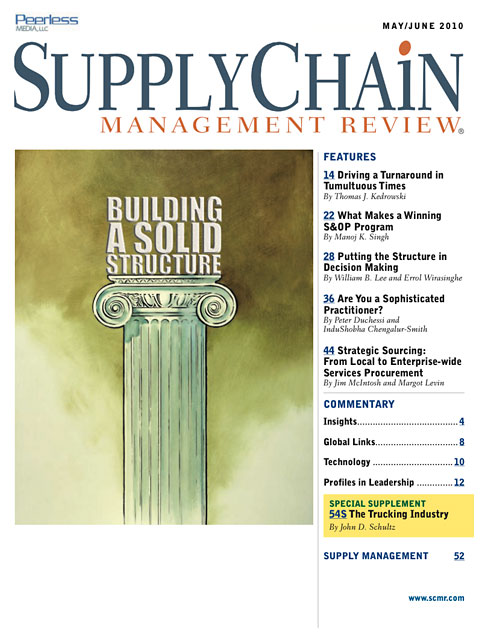Sorry, but your login has failed. Please recheck your login information and resubmit. If your subscription has expired, renew here.
May-June 2010
Spring is a time for renewal. It's a time for re-assessing the way we've been doing things and making changes in a manner that ensures forward progress. That's a recurring theme of the articles in the May/June issue of Supply Chain Management Review. With the building blocks in place and the spirit of renewal in full bloom, who knows what level of supply chain excellence can be achieved? Browse this issue archive.Need Help? Contact customer service 847-559-7581 More options
Many supply chain managers make the critical error or equating making decisions with solving problems. Decision making is not problem solving. Decision making is specific to the person. Problem solving is specific to the problem. Our work suggests that problem solvers are not necessarily the best decision-makers, and perhaps vice versa.
We have all heard the jokes liked “to a surgeon, cutting can fix anything” or “to a chiropractor, manipulation can fix anything” or “to a psychologist, everything’s mental.” These jokes are, of course, not fair to those professionals, particularly the good ones. But don’t we have the same kind of =phenomenon with our supply chain decision making? Some will advocate that “lean can fix everything” or hat “everyone needs to do Six Sigma.”
Again, we don’t want to criticize the advocates of those techniques, just as we don’t want to disparage surgeons or chiropractors of psychologists. It’s just that we need to take a longer, more analytical look at our supply chain decisions and not simply jump in with the latest buzzword. We believe one of the reason companies have so much trouble with their supply chains is a lack of structured decision-making process…We offer seen steps to a more structured approach to supply chain decision-making.
 |
This complete article is available to subscribers
only. Click on Log In Now at the top of this article for full access. Or, Start your PLUS+ subscription for instant access. |
Not ready to subscribe, but need this article?
Buy the complete article now. Only $20.00. Instant PDF Download.
Access the complete issue of Supply Chain Management Review magazine featuring
this article including every word, chart and table exactly as it appeared in the magazine.
SC
MR
Sorry, but your login has failed. Please recheck your login information and resubmit. If your subscription has expired, renew here.
May-June 2010
Spring is a time for renewal. It's a time for re-assessing the way we've been doing things and making changes in a manner that ensures forward progress. That's a recurring theme of the articles in the… Browse this issue archive. Download a PDF file of the May-June 2010 issue.
 |
Download Article PDF |
Many supply chain managers make the critical error or equating making decisions with solving problems. Decision making is not problem solving. Decision making is specific to the person. Problem solving is specific to the problem. Our work suggests that problem solvers are not necessarily the best decision-makers, and perhaps vice versa.
We have all heard the jokes liked “to a surgeon, cutting can fix anything” or “to a chiropractor, manipulation can fix anything” or “to a psychologist, everything’s mental.” These jokes are, of course, not fair to those professionals, particularly the good ones. But don’t we have the same kind of =phenomenon with our supply chain decision making? Some will advocate that “lean can fix everything” or hat “everyone needs to do Six Sigma.”
Again, we don’t want to criticize the advocates of those techniques, just as we don’t want to disparage surgeons or chiropractors of psychologists. It’s just that we need to take a longer, more analytical look at our supply chain decisions and not simply jump in with the latest buzzword. We believe one of the reason companies have so much trouble with their supply chains is a lack of structured decision-making process…We offer seen steps to a more structured approach to supply chain decision-making.
 |
SUBSCRIBERS: Click here to download PDF of the full article. |
SC
MR

Latest Supply Chain News
- How S&OP provides the answer to in-demand products
- AI, virtual reality is bringing experiential learning into the modern age
- Humanoid robots’ place in an intralogistics smart robot strategy
- Tips for CIOs to overcome technology talent acquisition troubles
- There is still work to do to achieve supply chain stability
- More News
Latest Podcast

 Explore
Explore
Latest Supply Chain News
- How S&OP provides the answer to in-demand products
- AI, virtual reality is bringing experiential learning into the modern age
- Humanoid robots’ place in an intralogistics smart robot strategy
- Tips for CIOs to overcome technology talent acquisition troubles
- There is still work to do to achieve supply chain stability
- Blooming success: The vital role of S&OE in nurturing global supply chains
- More latest news
Latest Resources

Subscribe

Supply Chain Management Review delivers the best industry content.

Editors’ Picks





